by Lee Miller
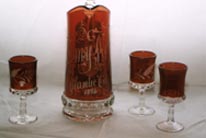
| Dakota Pattern by Lee Miller |
|
 |
DAKOTA, also known as BABY THUMBPRINT, was made by Ripley & Company in the 1880's and, when Ripley became Company F of the US Glass Company in 1891, it continued the pattern until about 1903. An excellent article on DAKOTA can be found in Lowell Innes' book: Pittsburgh Glass 1797-1891. A History and Guide for Collectors. Boston: Houghton Mifflin, 1976. |
| DAKOTA was made in a large variety of pieces and decoration, including ruby flashed. Several pieces are considered rare, including the covered cakestand which comes in three sizess: 8, 9, and 10 inch, plain and engraved. Alice Metz, in her book: Early American Pattern Glass, describes a 15 inch cover as well. | 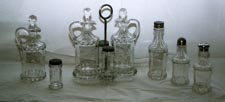 |
 |
The salad castor or cruet set and side bottles (especially with their original stoppers) and the sandwich or cake plate with bail are also rare. The more common pieces are bowls, covered compotes ranging from 5 to 10 inches on high standards, creamers, sugars, spooners, celeries, goblets, tumblers, pitchers and tankards in pint, quart and half gallon sizes and wine and water trays. There are also saloon pieces, such as salt and peppers and a mustard jar. |
| DAKOTA was produced plain, engraved fern and berry, oak leaves, fish and cattails, and birds and butterflies. As tankards are found with several other bird engravings, it was apparently possible to special order pieces. | 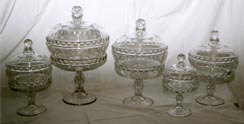 |
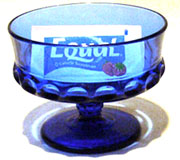 |
Threre are 2 forms of Dakota known to have been made in cobalt blue. One is the footed sauce dish shown on the left and one is a handled cup. The wine tray(shown on the right) and water trays were examples of the pattern made with the 'pie crust' molded edges. |
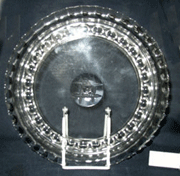 |
| Dakota was one of the States' series of patterns made by the U S Glass Co. between ca 1891 and 1908. On the right is a reprint of the catalog showing pieces of Dakota pattern including the table set, shaker, stems and some flat & footed sauce dishes. Note that the text below the picture refers to the "No. 76 or Fern Berry etching". To be correct, that 'colorless decor' is engraved, not etched. See the PatternGlass.com Lesson on colorless decor HERE. |
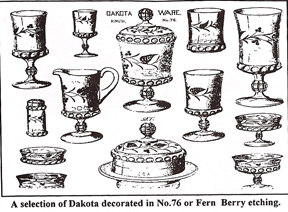 |
 |
 |
 |
 |